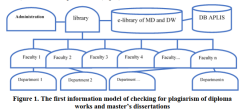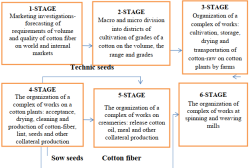 RESULTS OF INTEGRATION OF INFORMATION SYSTEM IN CORPORATE NETWORK OF TASHKENT UNIVERSITY OF INFORMATION TECHNOLOGIES
RESULTS OF INTEGRATION OF INFORMATION SYSTEM IN CORPORATE NETWORK OF TASHKENT UNIVERSITY OF INFORMATION TECHNOLOGIES
Author: Karimov Uktam Ulugbekovich
Abstract:
In this article, models and solutions for the integration of such educational automated systems as the information library system (ILS) and the antiplagiarism system are examined. Integration of systems is based on the compatibility of databases, if more precisely in the metadata of different information models. At the same time, Cloud technologies are used - data processing technology, in which computer resources are provided to the user of the integrated system as an online service. ILS creates e-library of graduation papers and dissertations on the main server. During the creation of the electronic catalog, the communication format MARC21 is used. The database development is distributed for each department. The subsystem of anti-plagiarism analyzes the full-text database for the similarity of texts (dissertations, diploma works and others). Also it identifies the percentage of coincidence, creates the table of statistical information on the coincidence of tests for each author and division, indicating similar fields. The integrated system was developed and tested at the Tashkent University of Information Technologies to work in the corporate mode of various departments (faculties, departments, TUIT branches).

 CONDITIONS OF SYSTEMATIC APPROACH IN DEVELOPING INTERDISCIPLINARY RELATIONS IN AN EDUCATIONAL PROCESS (The Elementary Class is an example of natural science classes)
CONDITIONS OF SYSTEMATIC APPROACH IN DEVELOPING INTERDISCIPLINARY RELATIONS IN AN EDUCATIONAL PROCESS (The Elementary Class is an example of natural science classes)
Author: Ismoilov Bobur Tohirovich, Salokhitdinova Navruza Murodullaevna
Abstract:
This article discusses aspects that should be taken into account when shaping interdisciplinary learning in the learning process. It also describes the pedagogical conditions of a systematic approach, as well as how the learning process can be effectively achieved. The author outlines the systematic approach to formulate interdisciplinary attitudes through the example of natural sciences taught in primary classes. This article considers that the system of education in the system of education, which is historically composed, has to be preserved, and now it must be independent of academic subjects. Each of them expresses a separate field of science with its own language, conceptual apparatus, methodology, methodology, research subject and concept. At the same time, opportunities should be created for their interconnected learning. The conclusion that this opportunity has been provided by the author in the methodology of the interdisciplinary approach, as well as the integration of curriculum as a method of synthesis of subjective knowledge, has been proven in the conclusion.
 EVOLUTION OF ETHNOCULTURAL TOURISM IN UZBEKISTAN
EVOLUTION OF ETHNOCULTURAL TOURISM IN UZBEKISTAN
Author: Safarova Tumaris Rustamkulovna
Abstract:
This article examines the genesis of ethno cultural tourism, the features of its manifestation at various social historical stages and situations, and its manifestations in the history of Eastern peoples.
 INTEGRATION OF NATIONAL AND UNIVERSAL CULTURE IN THE CONDITION OF GLOBALIZATION
INTEGRATION OF NATIONAL AND UNIVERSAL CULTURE IN THE CONDITION OF GLOBALIZATION
Author: Farxodjonova Nodira Farxodjon qizi
Abstract:
In this article highlights the specific features of national and universal culture, its components, its appearance and the changes taking place in the process of integration, modernization in the conditions of globalization, and issues such as the preservation, development of national culture.
 INTEGRATION IN THE NATIONAL LANGUAGE IN THE CONTEXT OF GLOBALIZATION: SOCIO-PHILOSOPHICAL ANALYSIS
INTEGRATION IN THE NATIONAL LANGUAGE IN THE CONTEXT OF GLOBALIZATION: SOCIO-PHILOSOPHICAL ANALYSIS
Author: Farxodjonova Nodira Farxodjon qizi
Abstract:
As you know, language is the most powerful means of preserving material, spiritual heritage and enriching national culture. As the content of culture, language is a means of uniting national culture into a single semantic field and creating a single thesaurus of people who carrier it from generation to generation. In this article, the socio – philosophical analysis of the process of integration in the national language in the context of globalization.
 PECULIARITIES OF USING CLUSTER METHOD IN INTEGRATION OF INTER-BRANCH STRUCTURES IN AGROINDUSTRIAL COMPLEX
PECULIARITIES OF USING CLUSTER METHOD IN INTEGRATION OF INTER-BRANCH STRUCTURES IN AGROINDUSTRIAL COMPLEX
Author: Kholikova Rukhsora Sanjarovna
Abstract:
The article examines the role of the cluster approach in the integration of structures in the agro-industrial complex in the production of raw cotton, processing of fiber and obtaining from it competitive final products for the internal and foreign markets. There are also considered features of application of a cluster method in formation of integrated in agro-industrial complex in processing of raw cotton and receiving from it competitive ready-made products for domestic and foreign markets. Drawbacks of low clustering in agro-industrial complex are revealed.
